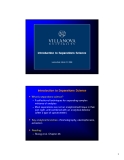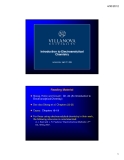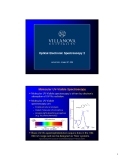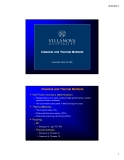
Oil and gas transport
-
The velocity at which radiation travels (or propagates) through a medium is dependent on the medium itself When radiation travels through a medium and does not undergo a frequency change, it cannot be undergoing a permanent energy transfer However, radiation can still interact with the medium – Radiation, an EM field, polarizes the electron clouds of atoms in the medium – Polarization is a temporary deformation of the electron clouds
 14p
14p  qdung92ct
qdung92ct
 03-07-2012
03-07-2012
 78
78
 6
6
 Download
Download
-
IUPAC Definition: chromatography is a physical method of separation in which the components to be separated are distributed between two phases, one of which is stationary while the other moves in a definite direction Stationary phase (SP): common name for the column packing material in any type of chromatography Mobile phase (MP): liquid media that continuously flows through the column and carries the analytes Analyte: the chemical species being investigated (detected and quantitatively measured) by an analytical method...
 19p
19p  qdung92ct
qdung92ct
 03-07-2012
03-07-2012
 85
85
 11
11
 Download
Download
-
Matched against a wide range of spectroscopic and chromatographic techniques, the techniques of electroanalytical chemistry find an important role for several reasons: – Electroanalytical methods are often specific for a particular oxidation state of an element – Electrochemical instrumentation is relatively inexpensive and can be miniaturized – Electroanalytical methods provide information about activities (rather than concentration)
 19p
19p  qdung92ct
qdung92ct
 03-07-2012
03-07-2012
 79
79
 6
6
 Download
Download
-
UV-Visible spectra can be interpreted to help determine molecular structure, but this is presently confined to the analysis of electron behavior in known compounds. Information from other techniques (NMR, MS, IR) is usually far more useful for structural analysis However, UV-Vis evidence should not be ignored!
 18p
18p  qdung92ct
qdung92ct
 03-07-2012
03-07-2012
 61
61
 5
5
 Download
Download
-
Aldehydes and Ketones – Form acetals and ketals respectively with normal methanol-containing reagents – Water formed in this reaction will then be titrated to give erroneously high water results – With aldehydes a second side reaction can take place, consuming water, which can lead to sample water content being underestimated – Replacing methanol with another solvent can solve the difficulties (commercial reagents are widely available)
 14p
14p  qdung92ct
qdung92ct
 03-07-2012
03-07-2012
 80
80
 7
7
 Download
Download















